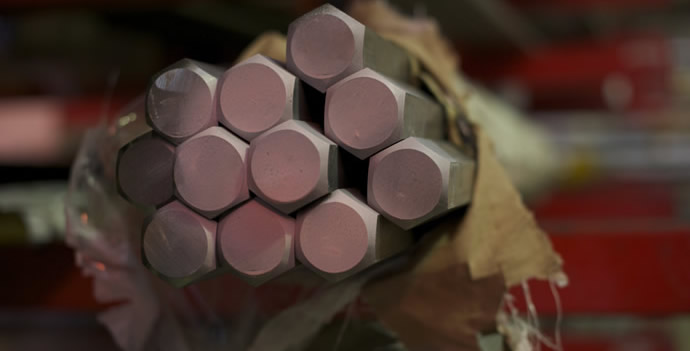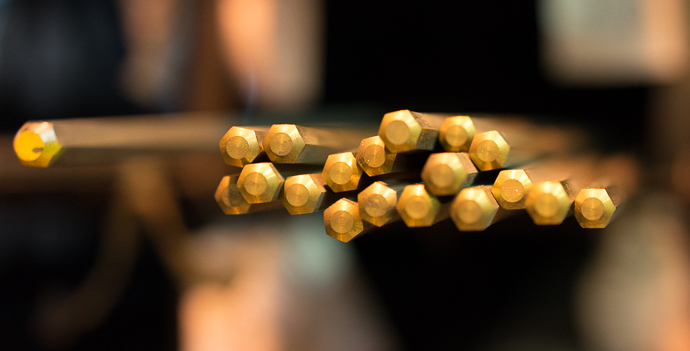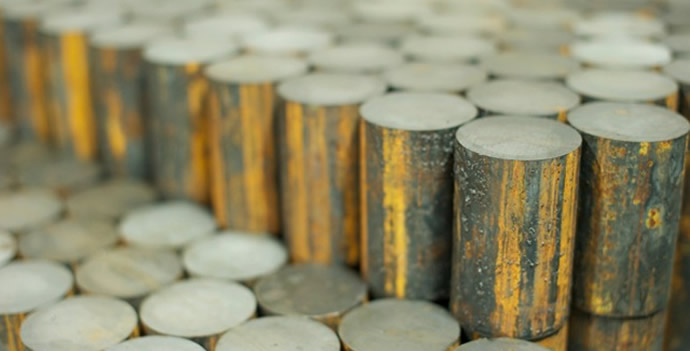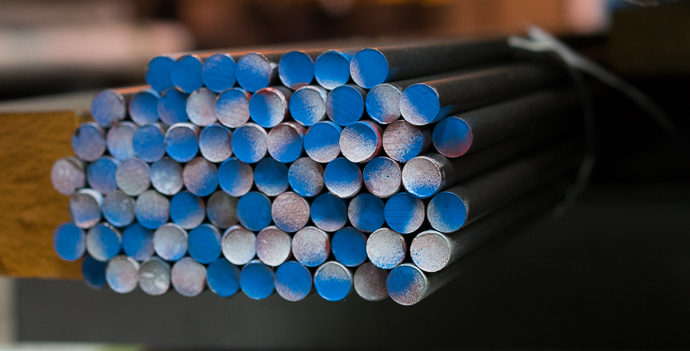Robots inside you, sensitive robotic hand, fibre-optic spying and more
As aluminium suppliers we’re always interested to hear weird science stories about the metal. As popular steel suppliers in the UK, we like tall steel tales just as much. As the summer holidays rumble on, we’ve discovered a bunch of fascinating metal-inspired stories for you.
Tiny metallic robots inside you
Make tiny battery-less robots from metallic powder. Stick them to plastic tape. Control them using magnetic fields. What do you get? A robot that could crawl inside you, get into your internal organs, and repair them, for example delivering drugs to the site. They might also be able to get into the guts of computers to mend broken circuits.
A team at the Chinese University of Hong Kong has found an easy way to make the robots at low cost, using simple sticky tape and a non-sticky printed wax. Then they add a powder coating made of microparticles of magnetic neodymium-iron-boron. This sticks to the robot, but not to the wax overlay, which works like a stencil. When the wax is dissolved you get a specially-shaped magnetic robot. One day they could even be printed onto rolls like wallpaper.
There’s only one problem, and it’s a biggie. The team is using a very strong magnet called a neodymium-iron-boron magnet, which isn’t safe. In fact it’s “kind of toxic to the cells.”
Robotic hand crushes beer cans and holds eggs without breaking them
An incredibly gentle programmable robot hand can hold delicate objects like eggs and computer chips without breaking them. It pours drinks with ease, cuts paper with scissors, and can use tweezers. At the same time it’s strong enough to crush beer cans. Scientists say it could make an excellent prosthetic hand in future.
The hand weights just over a kilo, is 22cm long, and is made of steel and aluminium. The fingers are run by three small motors in the palm of the hand, which move the tendon-like metal parts around twenty different joints. This means the fingers can move sideways, move back and forth, and fold like a real human hand
Fibre-optic cable tech spies on people’s conversations
Fibre-optic cables, like the ones the internet runs on, can be used to spy on people, detecting what they’re saying from as far as 1km away. Previously, researchers discovered optical fibres can be used as sensors to detect things like whales and earthquakes. Now a team at a Chinese university has built a device using optical fibres to listen to people chatting close by. As one team member said, “Optical fibres are very sensitive to vibration so any fibre placed in a building is actually a sort of microphone that can tap any kind of conversation.”
It doesn’t have to happen. Adjusting the metal or glass coating of the fibres makes them less sound-sensitive. The team tried wrapping steel wire around the fibres in the lab, leaving their listening device unable to pick up any meaningful sound waves.
Earth has 4000 more minerals than we thought
You re-classify something, and suddenly there’s loads more of it. That’s what might happen to the minerals found on our planet. Some scientists say we need to re-organised mineral classification based on how they’re formed as well as the traditional way, by their make-up. Others say it’s crazy talk, potentially increasing the number of known minerals by 75%.
The scientists involved discovered minerals can be made in 57 different ways, including asteroid collisions, oxidisation and evaporation, and through metal deposits left behind by micro-organisms. The new field is called ‘mineral informatics’.
Charge your mobile with a woolly jumper
Do you fancy a jumper whose integral wireless charger will keep your gadgets topped up with power? Not a problem. There is such a thing, and it contains tiny tubes filled with a liquid metal alloy. It can wirelessly charge wearable and portable devices like medical sensors, movement trackers, and phones.
The problem with this kind of tech, so far, has been the wireless charger element, which generates electromagnetic radiation that can damage the skin at close range with long exposure. This is different. You can hook up the new jumper to a little pocket power supply. When the current flows through the garment it makes low levels of electromagnetic radiation. If your device has a receiver coil built in, it can change the radiation back into electricity and charge the batteries.
Called the MeanderCoil++, the tech delivers as much as 10 watts of charge, about the same as a regular mobile charger.
Get your metals here!
Want aluminium supplies, steel, cast iron or copper? Whatever the format, we have it in stock for you at a fair price.
Asteroid fail, copper-jawed mini monster, lithium-ion gets a boost
Japan bombed an asteroid… and nothing happened. Old-school copper wiring is enjoying a speed boost thanks to cool science. Copper-rich bloodworm jaws build themselves, and the process is completely amazing. Plus – electric car charging might be about to become a lot faster. Here’s the news.
Old twisted pair copper telephone wire tech gets exciting
Ordinary copper telephone wire is just about to get a lot more exciting. Old re-purposed phone lines mean many UK households suffer from slow download speeds and rubbish internet access. Now there could be a fix.
Fibre-optic cable is very expensive. Now researchers say ordinary old copper telephone wire could hit data rates three times higher than we get now, at a fraction of the cost, over small distances. The technique could support an easier transition to UK-wide fibre optic, and be really handy in other countries who use the same twisted-pair copper wire.
In copper wire, signals are sent via an electrical current along the whole cable, end to end. Data transmission is limited by how fast the current can be changed. Current copper broadband connections work at below 1 gigahertz, but this can in theory get as high as 5 gigahertz thanks to a small, cheap component called a balun.
While more research is needed to prove the theory, the team working on it reckons 3 gigabits a second is possible. That’s triple the theoretical maximum in a world where, in reality, copper wire broadband only delivers maximum speeds of 80 megabits a second.
Bloodworm’s copper jaws inspire self-build materials
Bloodworms, which live in mud in the floor of oceans, have unusual amounts of copper in their venom-injecting jaws. But they use just one protein to build their fangs, and this simple protein might inspire new ways to build materials.
A team at the University of California in Santa Barbara has been studying the creature’s 2mm jaws, made of 10% copper, built to last the worm’s lifetime, and as tough as bronze. It even gives some ceramics a run for their money.
The team used advanced molecular and mechanical analysis and modelling to figure out the jaws’ composition and pin down exactly how they’re built. Apparently the protein controls the process, starting off by binding copper from the environment. It mixes the metal in a watery solution, then separates it to leave a dense liquid. This converts an amino acid into melanin, which makes the bloodworm’s jaws very wear-resistant.
The resulting composite material is super-strong, despite the hard-working protein being unusually simple. In one of the team member’s words, “It really does boggle the mind.” The finding could help engineers improve composite materials that might be able to build themselves.
A brilliantly efficient battery for charging electric cars
Would you like to charge your electric car 60% in 60 seconds? Wouldn’t we all. A new kind of lithium ion battery is capable of doing exactly that thanks to copper nanowires.
Lithium-ion batteries use binding agents to create a solid anode, giving slower charging times. A team at the University of Science and Technology of China has designed an alternative with a clever structured positive end or anode.
The graphite particles inside a lithium battery usually fall into a random order. The scientists organised the particles by size while fiddling with ‘porosity’, a feature of electrodes. Higher porosity in the top of the anode and lower porosity in the bottom lets the battery charge from zero to 60% in 5.6 minutes and 80% in 11.4 minutes, while still storing a high amount of energy.
How did they do it? They coated the graphite anode particles with copper and mixed in copper nanowires before heating the particles, cooling and compressing them, then setting the new structure in place. In a world where a Tesla takes 40-60 minutes to fully charge, it makes a huge difference
What happened when Japan bombed an asteroid
Back in 2019 a Japanese spacecraft bombed an asteroid… and it barely moved. The Hayabusa 2 craft bombed asteroid Ryugu, shooting a 2.5kg chunk of copper at it in an attempt to make a crater. The team expected the impact to shake the asteroid, moving large rocks on its surface around. But it hardly had any effect. The rocks moved less than 1m, suggesting the seismic waves were a lot weaker than they thought.
This means the asteroid must be as much as 100 times better at resisting seismic activity than the moon. It might be down to the dust grains on Ryugu, which are a lot bigger than these on the moon so are better at scattering the waves.
Metals ahoy
We’re aluminium extrusion suppliers and aluminium plate suppliers. We’re expert steel suppliers, UK based and widely trusted. Metalex products are good quality, fairly prices, and backed by superb service and expert advice. If you need metals, we’re always happy to help.
Please complete the enquiry form located on this page, call +44 (0) 330 223 2653 or email us to discover how Metalex could be supplying you with premium metal products and professional metal processing services.
THE LATEST FROM THE BLOG
METAL PRODUCTS








